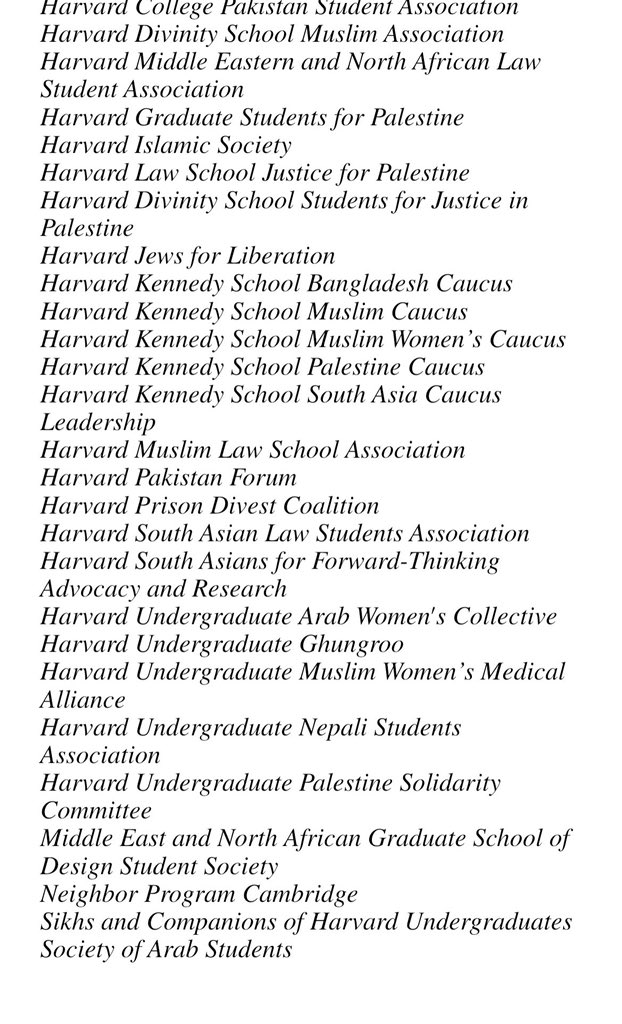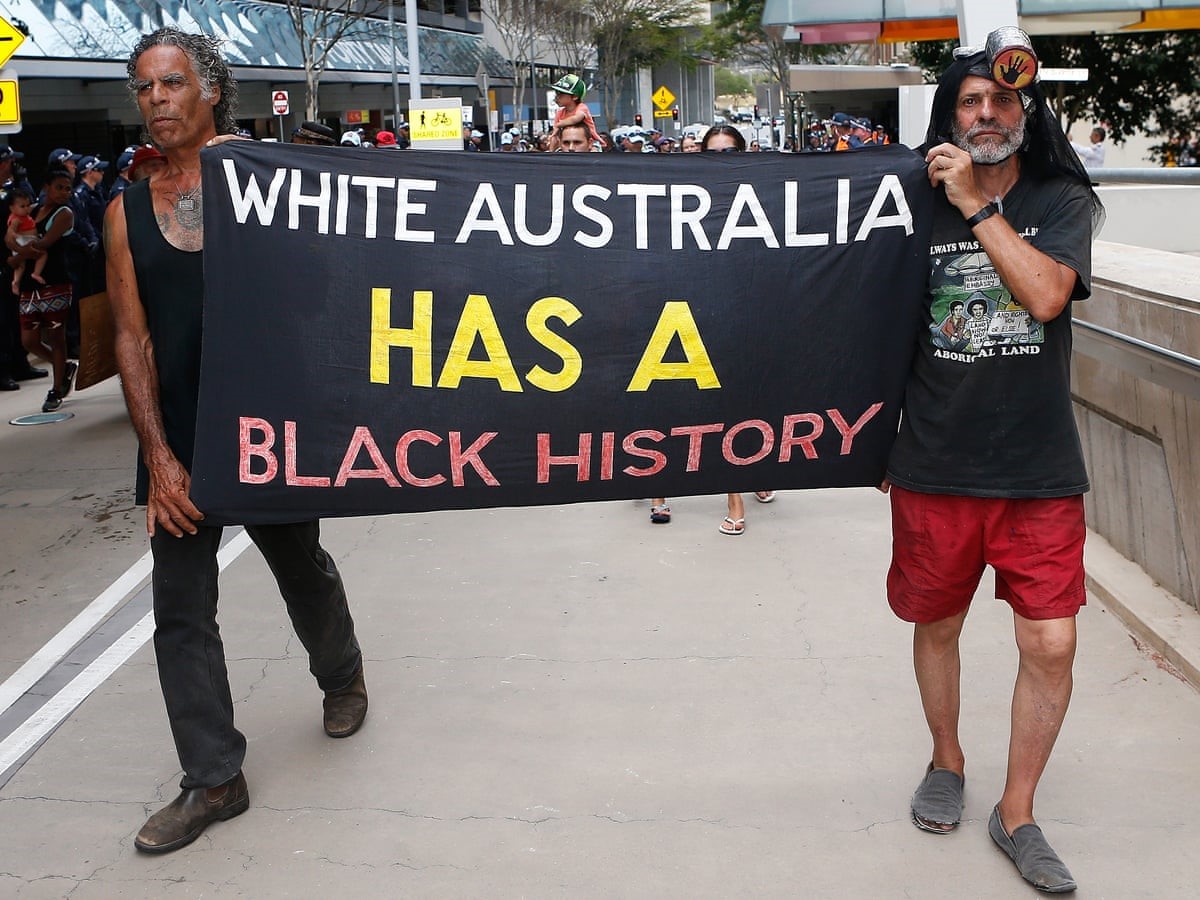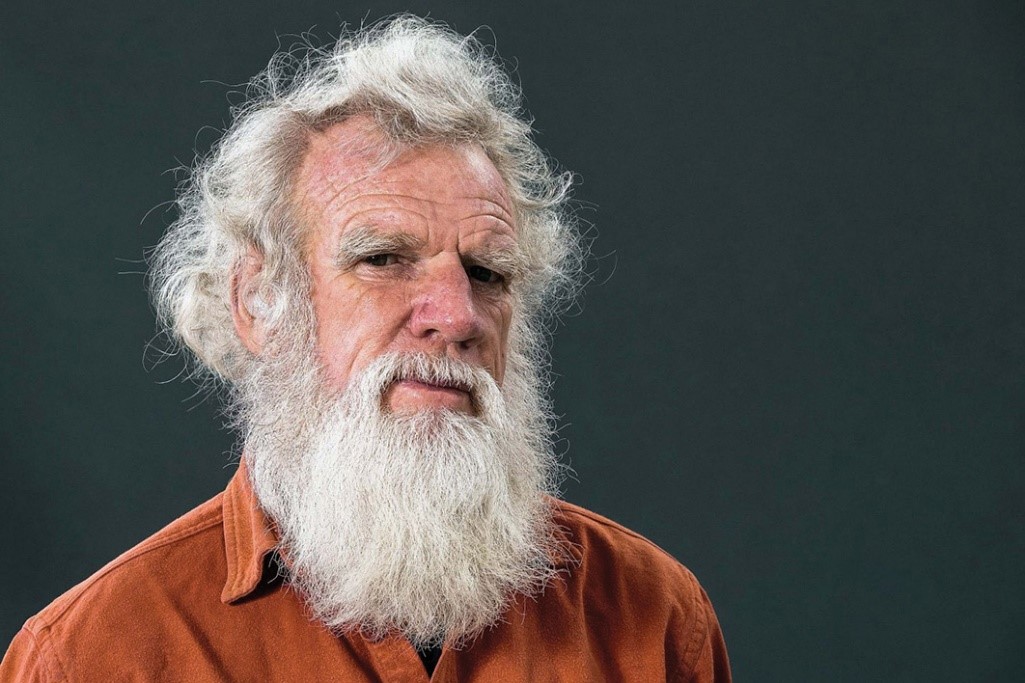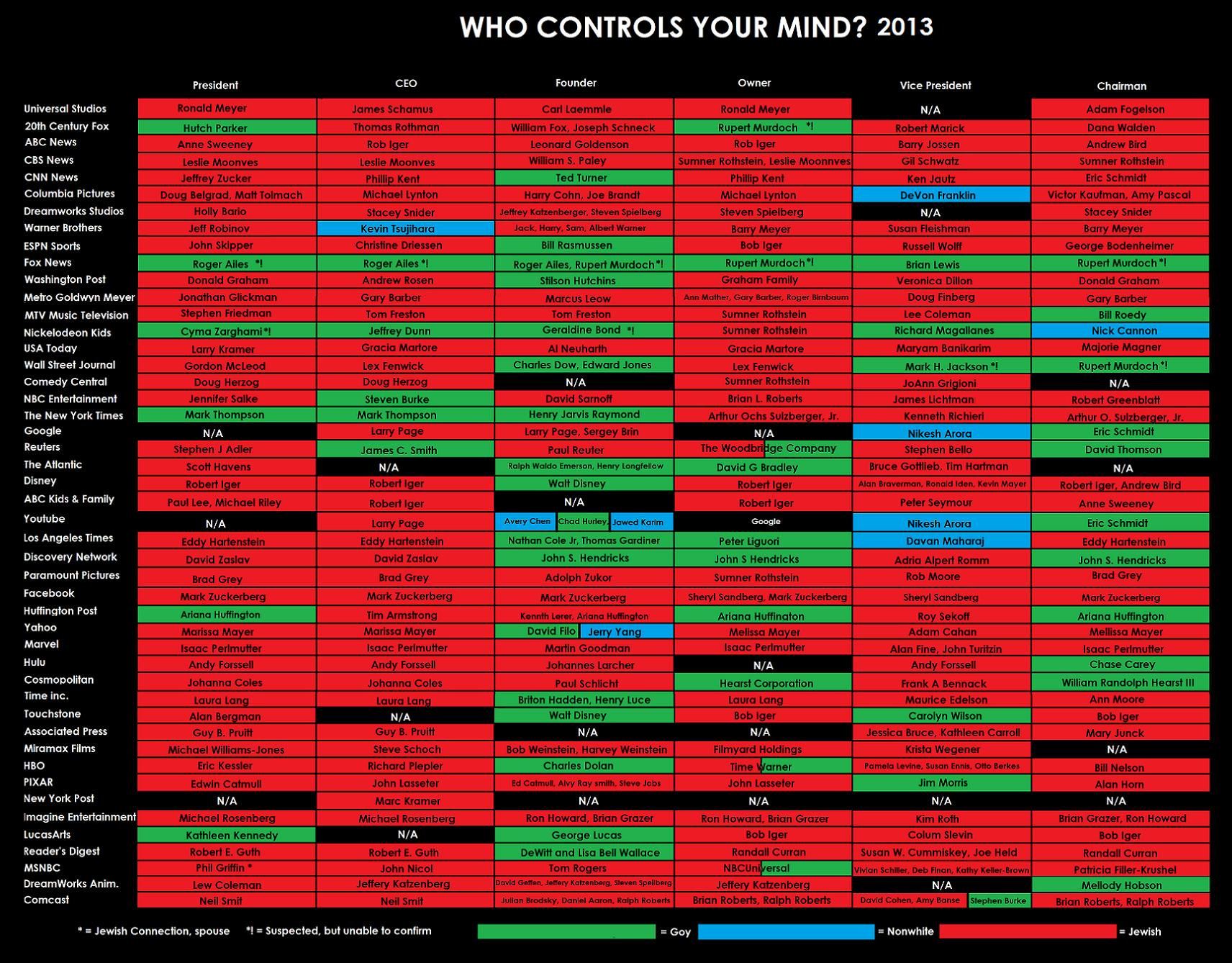Why Are Jews So Influential?
Jewish populations have always had enormous effects on the societies in which they reside because of several qualities that are central to the Jewish group evolutionary strategy and likely have been under genetic selection in Ashkenazi Jewish groups: First and foremost, Jews are ethnocentric and able to cooperate in highly organized, cohesive, and effective groups. Also important is high intelligence, including the usefulness of intelligence in attaining wealth, prominence in the media, and eminence in the academic world and the legal profession. I will also discuss two other qualities that have received less attention: psychological intensity and aggressiveness, and finally mention the Jewish guru phenomenon.
The four background traits of ethnocentrism, intelligence and wealth, psychological intensity, aggressiveness, along with strong charismatic leadership result in Jews being able to produce formidable, effective groups—groups able to have powerful, transformative effects on the peoples they live among. In the post-Enlightenment world, these traits influence the academic world and the world of mainstream and elite media, thus amplifying Jewish effectiveness compared with traditional societies. However, even before the Enlightenment Jews have repeatedly become an elite and powerful group in societies in which they reside in sufficient numbers.
It is remarkable that Jews, usually as a tiny minority, have been central to a long list of historical events. Jews were much on the mind of the Church Fathers in the fourth century during the formative years of Christian dominance in the West. Indeed, I have proposed that the powerful anti-Jewish attitudes and legislation of the fourth-century Church must be understood as a defensive reaction against Jewish economic power and enslavement of non-Jews.[1] Jews who had nominally converted to Christianity but maintained their ethnic ties in marriage and commerce were the focus of the 250-year Inquisition in Spain, Portugal, and the Spanish colonies in the New World. Fundamentally, the Inquisition should be seen as a defensive reaction to the economic and political domination of these “New Christians.”[2]
Nineteenth-century critics of Jews typically complained about Jewish influence in the media and Jewish wealth that often made traditional Western aristocratic elites subservient to them, and, like Richard Wagner, they complained about Jewish influence on culture.[3] Jews have also been central to all the important events of the twentieth century. Jews were a necessary component of the Bolshevik revolution that created the Soviet Union and willing participants of horrendous mass murders of its early decades, and they remained an elite group in the Soviet Union until well after World War II.[4] They were a central focus of National Socialism in Germany, in part because of the Jewish role in Bolshevism, and they have been prime movers of the post-1965 cultural and multicultural/multiethnic revolution in the United States, including the encouragement of massive non-White immigration to countries of European origin.[5] In the contemporary world, organized American Jewish lobbying groups and deeply committed neoconservative Jews in the Bush administration and the media had a critical role in fomenting wars that benefit Israel, and now neocon Jews in the Biden administration have established the all-out support for Ukraine against Russia and Israel against Hamas. Right now the ADL is leading the campaign to expunge social media of ideas they don’t like, particularly on X (Twitter), and Jewish billionaires are blacklisting students and withholding funds from universities if they don’t express enthusiastic support for Israel.[6] Indeed, I would say that we are once again witnessing an incredible display of Jewish power in the U.S.
How can such a tiny minority have such huge effects on the history of the West? I will not discuss the role of Western individualism in facilitating Jewish influence.[7] We tend to see people as individuals, as in the ideology of colorblind meritocracy so common among mainstream conservatives.
Jews are Ethnocentric
Elsewhere I have argued that Jewish ethnocentrism can be traced back to their Middle Eastern origins.[8] Traditional Jewish culture has a number of features identifying Jews with the ancestral cultures of the area. The most important of these is that Jews and other Middle Eastern cultures evolved under circumstances that favored large groups dominated by males.[9] These groups were basically extended families with high levels of endogamy (i.e., marriage within the kinship group) and consanguineous marriage (i.e., marriage to blood relatives), including the uncle-niece marriage sanctioned in the Old Testament. These features are exactly the opposite of Western European tendencies.
Whereas Western societies tend toward individualism, the basic Jewish cultural form is collectivism, in which there is a strong sense of group identity and group boundaries, and moral particularism represented by the phrase “Is it good for the Jews.” In Jewish religious writings, non-Jews had no moral standing and could be exploited at will as long as doing so didn’t harm the entire group. Middle Eastern societies are characterized by anthropologists as “segmentary societies” organized into relatively impermeable, kinship-based groups.[10] Group boundaries are often reinforced through external markers such as hair style or clothing, as Jews have often done throughout their history. Different groups settle in different areas where they retain their homogeneity alongside other homogeneous groups, as illustrated by the following account from Carleton Coon:
There the ideal was to emphasize not the uniformity of the citizens of a country as a whole but a uniformity within each special segment, and the greatest possible contrast between segments. The members of each ethnic unit feel the need to identify themselves by some configuration of symbols. If by virtue of their history they possess some racial peculiarity, this they will enhance by special haircuts and the like; in any case they will wear distinctive garments and behave in a distinctive fashion.[11]
Jews are at the extreme of this Middle Eastern tendency toward collectivism and ethnocentrism. I give many examples of Jewish ethnocentrism in my trilogy on Judaism—perhaps most notably ethnic networking that was so important to The Culture of Critique—and have argued in several places that Jewish ethnocentrism is biologically based.[12]
A good start for thinking about Jewish ethnocentrism is the work of Israel Shahak, most notably his co-authored Jewish Fundamentalism in Israel.[13] Present-day fundamentalists attempt to re-create the life of Jewish communities before the Enlightenment (i.e., prior to about 1750). During this period the great majority of Jews believed in the Kabbala—the Jewish mystical tradition. Influential Jewish scholars like Gershom Scholem ignored the obvious racialist, exclusivist material in the Kabbalistic literature by using words like “men,” “human beings,” and “cosmic” to suggest the Kabbala has a universalist message. The actual texts say salvation is only for Jews, while non-Jews have “Satanic souls.”[14]
The ethnocentrism apparent in such statements was not only the norm in traditional Jewish society, but remains a powerful current of contemporary Jewish fundamentalism, with important implications for Israeli politics. For example, the Lubavitcher Rebbe, Rabbi Menachem Mendel Schneerson, describing the difference between Jews and non-Jews:
We do not have a case of profound change in which a person is merely on a superior level. Rather we have a case of…a totally different species…. The body of a Jewish person is of a totally different quality from the body of [members] of all nations of the world…. The difference of the inner quality [of the body]…is so great that the bodies would be considered as completely different species. This is the reason why the Talmud states that there is an halachic difference in attitude about the bodies of non-Jews [as opposed to the bodies of Jews]: “their bodies are in vain”…. An even greater difference exists in regard to the soul. Two contrary types of soul exist, a non-Jewish soul comes from three satanic spheres, while the Jewish soul stems from holiness.[15]
These people and secular ethono-nationalists who have basically the same ideas are firmly in charge in Israel, leading to a long series of protests by liberal Jews in Israel and the US. There are a million more examples but in the interests of brevity I’ll leave it at that. Even a prominent Israel apologist like Thomas Friedman of the NYTimes recently wrote that the present government as a “far-right coalition of Jewish supremacists and ultra-Orthodox Jews.” But AIPAC still dominates Congress and the Executive branch, so there won’t be any changes soon.
From Mondoweiss:
When Rep. Jayapal called Israel a racist state in July, Democrats and Republicans leaped on her in a political feeding frenzy. They fell over each other to cash in on the defense of Israel, a state whose racism is not just obvious but a point of pride for many in its government. They immediately and overwhelmingly passed a resolution stating that “the State of Israel is not a racist or apartheid state.” Jayapal, of course, voted with the majority. The nine who voted against were all progressives who are atop the list of AIPAC’s most hated. It breezed through the Senate by unanimous consent. Jayapal, of course, voted with the majority. The nine who voted against were all progressives who are atop the list of AIPAC’s most hated. It breezed through the Senate by unanimous consent.
Similar overwhelming support for Israel in the Gaza war passed the House of Representatives and it was unanimous in the Senate. Republicans and conservatives generally are especially supportive of Israel.
Same with conservative media. I am not sure why this is. Part of it is probably because a significant portion of their audiences are evangelicals who think Israel’s success will inaugurate the Second Coming of Jesus and the end times. It may also be their desire to gain legitimacy in a cultural environment that is completely dominated by the left which accuses anyone to the right of Mitt Romney of being a raving Nazi.
Ethnocentrism is responsive to particular environmental triggers, what evolutionists term “facultative mechanisms,” that is, mechanisms that can be triggered by external circumstances such as perceived threat. The phenomenon of a siege mentality has been mentality noted by many authors as typical of Jewish culture throughout history (see A People That Shall Dwell Alone, Ch. 7, pp. 218–219).
A permanent sense of imminent threat appears to be common among Jews. Writing on the clinical profile of Jewish families, Herz and Rosen (1982)[17] note that for Jewish families a “sense of persecution (or its imminence) is part of a cultural heritage and is usually assumed with pride. Suffering is even a form of sharing with one’s fellow-Jews. It binds Jews with their heritage–with the suffering of Jews throughout history.” Zborowski and Herzog (1952, 153)[18] note that the homes of wealthy Jews in traditional Eastern European shtetl communities sometimes had secret passages for use in times of anti-Semitic pogroms, and that their existence was “part of the imagery of the children who played around them, just as the half-effaced memory was part of every Jew’s mental equipment.”
A good example is how American Jews reacted to the 1967 war. Silberman notes that around the time of the 1967 Arab/Israeli war, many Jews could identify with the statement of Rabbi Abraham Joshua Heschel that “I had not known how Jewish I was.”[19] Silberman comments that “This was the response, not of some newcomer to Judaism or casual devotee but of the man whom many, myself included, consider the greatest Jewish spiritual leader of our time.” Many others made the same surprising discovery about themselves: Arthur Hertzberg wrote that “the immediate reaction of American Jewry to the crisis was far more intense and widespread than anyone could have foreseen. Many Jews would never have believed that grave danger to Israel could dominate their thoughts and emotions to the exclusion of everything else.”[20]
The current war in Gaza is no exception. Haredim, who usually avoid military service in order to devote their lives to study, are enlisting in the IDF and J Street, the liberal Zionist lobby is issuing context-free condemnations of Hamas. It’s the same with the Jewish faculty at my former university — liberals all and oblivious to the role of Israeli behavior in producing Palestinian hatred, but horrified that someone would tear down a poster of a Jewish hostage posted in a university building and trumpeting calls for free speech. (Where have they been in condemning the ADL’s pivotal role in censoring free speech on social media? Somehow I don’t think it’s an accident that I and a couple of my brothers-in-arms have been banned from X after Musk took over and is doing his best to avoid the wrath of the powers that be.) There are still voices like Jewish Voice of Peace and Mondoweiss that have long condemned Israeli policies toward the Palestinians, but they are definitely do not represent the vast majority of the power and money of the Jewish community in America.
This evolved response to external threat is often manipulated by Jewish authorities attempting to inculcate a stronger sense of group identification—for example, the messages of ever-increasing threat of anti-Semitism promulgated by the ADL — accompanied by pleas for donations.
Bar-Tal et al. (1992) note that
not surprisingly, Siege Mentality is related to Ethnocentrism. The belief that the world has negative intentions towards the group indicates its evil, malice, and aggressiveness. In this context, the group not only feels victimized and self-righteous, but also superior to the out-group.[21]
Jews Are Intelligent (and Wealthy)
The vast majority of American Jews are Ashkenazi Jews. This is a very intelligent group, with an average IQ of approximately 111 with a particular strength in verbal IQ. Since verbal IQ is the best predictor of occupational success and upward mobility in contemporary societies, it is not surprising that Jews are an elite group in the United States. Intelligence, as well as the other traits discussed here, were likely under genetic selection in traditional Ashkenazi societies because scholars were given marriages to the daughters of wealthy Jews and good business opportunities. Wealth and reproductive success were strongly linked at least prior to the nineteenth century.
Nevertheless, because of the demographic differences between Jews and White Americans, there are many more White Americans at any level of IQ required for upward mobility and leadership positions in American society. For example, at IQ of 140, there are five times as many White Americans as Jews. IQ is thus an insufficient explanation for Jewish influence.
Intelligence and ethnic networking are important for academic success, and in Chapters two and five of The Culture of Critique I showed that Jews and Jewish organizations led the intellectual effort to deny the importance of racial and ethnic differences in human affairs and to pathologize any sense of White identity or White interests. The Jewish role in creating the intellectual context of the 1965 immigration law relied on the success of the Boasian movement in anthropology in shaping academic views on race by dominating the American Anthropological Association since the 1920s. For example, historian of anthropology Gelya Frank noted “in message and purpose, [Boas’s anthropology] was an explicitly antiracist science.” This subverted the strong sense of race and racial interests that were prominent trends in academia and the mainstream media. Science is that lingua franca of the West, so the prestige of the Boasians was critical for their success.
Intelligence is also linked to wealth. Based on past results, Jews are probably around 35% of the wealthiest Americans, and that translates into a well-funded infrastructure of Jewish causes, from neocon think tanks to AIPAC to the ADL and political campaigns where the Democrat Party is basically funded by wealthy Jews and the Republican Jewish Coalition probably provides 40% of GOP donations aimed at supporting Israel and moving the GOP to the left on social issues. ADL Assets in 2021 were listed at $238,000,000; $62,000,000 in contributions. The national ADL, like the ACLU, the SPLC, the NAACP, and other so-called civil rights groups, is now merely a tax-exempt cadre of the Democratic Party and has gone all in on anti-White critical race theory, gender insanity, and opposition to any talk about the Great Replacement, claiming that the very idea is racist and anti-Semitic (while stating that Israel must retain its Jewish majority by controlling immigration and preventing Palestinians on the West Bank from voting). The ADL is a very prominent player in the censorship regime that pervades the left in the West. Right now the ADL is leading an aggressive campaign to expunge social media of ideas they don’t like, most famously on X (Twitter) so that Elon Musk is routinely labeled an anti-Semite in Jewish media and any mention of George Soros’s influence or calling out globalism is anti-Semitic. Because of their elite connections they have been able to pressure advertisers on Twitter, so that ad revenue is down 40% from pre-Musk days.
Intelligence is also evident in Jewish activism. Jews and Jewish organizations organized, led, funded, and performed most of the work of the most important anti-restrictionist organizations active from 1945–1965 and are still prominently involved. Jewish activism is like a full court press in basketball: intense pressure from every possible angle. But in addition to the intensity, Jewish efforts are very well organized, well-funded, and backed up by sophisticated, scholarly intellectual defenses. Intelligence and organization are also apparent in Jewish lobbying on behalf of Israel. Over thirty years ago US Defense Department official, noted that, “On all kinds of foreign policy issues the American people just don’t make their voices heard. Jewish groups are the exceptions. They are prepared, superbly briefed. They have their act together. It is hard for bureaucrats not to respond.”[22] At the time there was concern that the State Department remained a bastion of old school WASPs. Not a problem any longer, with neocons Anthony Blinken, Victoria Nuland, and Wendy Sherman firmly in charge of State.
Conscientiousness and Emotional Intensity
In Chapter 7 of my 1994 book on Judaism, I highlighted two personality traits of Jews, conscientiousness and emotional intensity. Both are heritable and quite likely under selection in traditional Jewish communities. Conscientiousness, which involves attention to detail, neatness, orderliness, striving for achievement, persistence toward goals in the face of difficulty, and the ability to focus attention and delay gratification is, along with IQ, linked to upward mobility. Social conscientiousness appears to be a sort of “don’t let down the group” trait, originally proposed by Darwin (1871) as the basis of group allegiance. Individuals high on this trait would be expected to feel intense guilt for having failed to fulfill their obligations to the group. Moreover, given the importance of conformity to group norms for Judaism, it would be expected that individuals who were low on this trait would be disproportionately inclined to abandon Judaism, while successful Jews who were the pillars of the community and thus epitomized the group ethic of Judaism would be disproportionately likely to be high on group conformity—and also likely to be reproductively successful in traditional societies. The result is that there would be strong selection pressures toward high levels of social conscientiousness within the Jewish community.
Conscientiousness was strongly emphasized in Jewish socialization. Thus, a child reared in a traditional Jewish home would have been socialized to continually monitor his/her behavior to ensure compliance with a vast number of restrictions—the vast number of commandments of the Ashkenazi religious writing. These are exactly the sorts of environmental influences expected to strengthen the conscientiousness system, what I call “system-specific environmental influences.”
Jews also tend to be high on the personality trait of affect intensity; i.e., they are prone to intense emotional experience of both positive and negative emotions.[23] Individuals high on affect intensity have more complex social networks and more complex lives, including multiple and even conflicting goals. They are prone to fast and frequent mood changes and lead varied and variable emotional lives. Clinically, affect intensity is related to cyclothymia (i. e., alternate periods of elation and depression), bipolar affective disorder (i.e., manic‑depressive psychosis), neurotic symptoms, and somatic complaints (nervousness, feeling uneasy, shortness of breath).
The common perception of Jewish and gentile psychiatric workers from the late nineteenth century until at least the end of the 1920s was that compared to gentiles, Ashkenazi Jews (and especially male Jews), had relatively sensitive, highly reactive nervous systems, thus making them more prone to the diagnoses of hysteria, manic‑depression, and neurasthenia (Gershon & Liebowitz 1975; Gilman 1993 92ff) and depression (men only). Gershon and Liebowitz note that 45 percent of 22 patients had bipolar affective disorder—about the same as in an Iraqi population—compared to 19 percent in a study of northern European populations. Within Israel, they cite an Israeli study (in Hebrew) that found that affective disorders were “much more prevalent” among Ashkenazi Jews than Sephardic Jews.[24] And a “preliminary” study found significantly more patients with affective psychoses and fewer with schizophrenia than among the non-Jews.[25] A study from 2000 found that in a sample of Israelis with bipolar disorder, the manic phase was “much more common in Israeli bipolar patients” than European and American populations (55 percent of the patients have illnesses characterized primarily by manias, 28 percent have approximately equal numbers of manias and depressions, and 17% suffer predominantly from depressions, but with no difference between Ashkenazi and Sephardic populations).[26]
I emphasize here that affect intensity is also linked to creativity and the manic phase of bipolar affective disorder which seems to be more common among Jews.[27] During episodes of mania the person has a grandiose self-image (“I am brilliant and can save the world if only people would listen to me”), goal-directed activity like obsessively working on a project all night, excessive involvement in pleasurable activity like buying sprees and sexual gratification, and racing thoughts which of course the manic person thinks are brilliant. The depressive part is just the opposite. But a lot of people may be high on emotionality but not meet the criteria for psychopathology. It’s easy to see that people moderately high on positive emotionality—hypomanic or normal but close to the manic range—would be high achievers; they would work persistently toward goals, and they would be very self-confident and with high self-esteem. Such people gravitate to leadership positions in whatever organization they are in. And it’s easy to see that they would become gurus, establishing a devoted following, like charismatic rabbis in traditional Jewish communities—Jewish gurus like Freud, Boas, Trotsky, etc. discussed in Culture of Critique.
For example, Albert Lindemann notes that many of Trotsky’s personality traits are stereotypically Jewish:
If one accepts that anti-Semitism was most potently driven by anxiety and fear, as distinguished from contempt, then the extent to which Trotsky became a source of preoccupation for anti-Semites is significant. Here, too, Johnson’s [i.e., Paul John, author of A History of the Jews] words are suggestive: He writes of Trotsky’s “demonic power”—the same term, revealingly, used repeatedly by others in referring to Zinoviev’s oratory or Uritsky’s ruthlessness [Zinoviev and Uritsky were two other prominent early Bolsheviks]. Trotsky’s boundless self-confidence, his notorious arrogance, and sense of superiority were other traits often associated with Jews. Fantasies there were about Trotsky and other Bolsheviks, but there were also realities around which the fantasies grew. (Albert Lindemann, Esau’s Tears Modern Anti-Semitism and the Rise of the Jews (Cambridge University Press, 1997, 448)
The Trotskyist movement was a heavily Jewish milieu and much loved by my radical Jewish acquaintances in college. A prominent Trotskyist Max Shachtman
attracted young Jewish disciples—the familiar rabbi-disciple model of Jewish intellectual movements (here, p. 17–18): “Youngsters around Shachtman made little effort to hide their New York background or intellectual skills and tastes. Years later they could still hear Shachtman’s voice in one another’s speeches.”[28] To a much greater extent than the Communist Party U.S.A, which was much larger and was committed to following the Soviet line, the Trotskyists survived as a small group centered around charismatic leaders like Shachtman, who paid homage to the famous Trotsky. In the Jewish milieu of the movement, Shachtman was much admired as a speaker because of his ability in debate and in polemics. He became the quintessential Hasidic guru—the leader of a close, psychologically intense group: “He would hug and kiss [his followers]. He would pinch both their cheeks, hard, in a habit that some felt blended sadism and affection.”[29]
Another example is Leo Strauss, a cult figure for neocons and the quintessential rabbinical guru, with devoted disciples such as Allan Bloom. Gertrude Himmelfarb (1974, 61) noted: “There are many excellent teachers. They have students. Strauss had disciples.”[30] And Levine: “This group has the trappings of a cult. After all, there is a secret teaching and the extreme seriousness of those who are ‘initiates.’”[31] Strauss relished his role as a guru to worshiping disciples, once writing of “the love of the mature philosopher for the puppies of his race, by whom he wants to be loved in turn.”[32]
The psychoanalyst Fritz Wittels noted long ago: “The faithful disciples [of Freud] regard one another’s books as of no account. They recognize no authority but Freud’s; they rarely read or quote one another. When they quote it is from the Master, that they may give the pure milk of the word.”[33]
Affect intensity influences the tone and intensity of Jewish activism. Among Jews there is a critical mass that is intensely committed to Jewish causes—a sort of 24/7, “pull out all the stops” commitment that produces instant, massive responses on Jewish issues. Jewish activism has a relentless, never-say-die quality. This intensity goes hand in hand with the “slippery slope” style of arguing: Jewish activism is an intense response because even the most trivial manifestation of anti-Jewish attitudes or behavior is seen as inevitably leading to mass murder of Jews if allowed to continue.
In my 1994 book I noted the historical pattern of a paranoid, siege mentality and desire for revenge that pervaded traditional Jewish communities. Interviews with New Left Jewish radicals revealed that many had destructive fantasies in which the revolution would result in “humiliation, dispossession, imprisonment or execution of the oppressors”[34] combined with the belief in their own omnipotence and their ability to create a non-oppressive social order—clearly indicating high self-confidence and self-esteem. The trend is towards low self-criticism and what amounts to psychopathic levels of high self-esteem.
Jews Are Aggressive
Much of the previous is also about Jewish aggressiveness. Jews have always behaved aggressively toward those they have lived among, and they have been perceived as aggressive by their critics. Being aggressive and “pushy” is part of the stereotype of Jews in Western societies. Unfortunately, there is a dearth of scientific studies on this aspect of Jewish personality, but Hans Eysenck, renowned for his research on personality and Phil Rushton’s inspiration on race differences, claims that Jews are indeed rated more aggressive by people who know them well.
In early twentieth-century America, the sociologist Edward A. Ross commented on a greater tendency among Jewish immigrants to maximize their advantage in all transactions, ranging from Jewish students badgering teachers for higher grades poor Jews attempting to get more than the usual charitable allotment. “No other immigrants are so noisy, pushing and disdainful of the rights of others as the Hebrews.”
The authorities complain that the East European Hebrews feel no reverence for law as such and are willing to break any ordinance they find in their way…. The insurance companies scan a Jewish fire risk more closely than any other [Jewish lightening]. Credit men say the Jewish merchant is often “slippery” and will “fail” in order to get rid of his debts. For lying the immigrant has a very bad reputation. In the North End of Boston “the readiness of the Jews to commit perjury has passed into a proverb.”
Albert Lindemann in his Esau’s Tears noted the same about Jewish perjury in Czarist Russia.
These characteristics have at times been noted by Jews themselves. In a survey commissioned by the American Jewish Committee’s study of the Jews of Baltimore in 1962, “two-thirds of the respondents admitted to believing that other Jews are pushy, hostile, vulgar, materialistic, and the cause of anti-Semitism. And those were only the ones who were willing to admit it.”[1]
[1] Yaffe 1968, 73. Yaffe embeds this comment in a discussion of self-hating Jews—implying that Jews are simply accepting stereotypes that are the fantasies of bigoted non-Jews.
Jews were unique as an American immigrant group in their hostility toward American Christian culture and in their energetic, aggressive efforts to change that culture. From the perspective of Henry Ford’s The International Jew, the United States had imported around 3.5 million mainly Yiddish-speaking, intensely ethnocentric Jewish immigrants over the previous forty years. In that very short period and long prior to achieving anything like the power they obtained after World War II and the 1960s counter-cultural revolution, Jews had had enormous effect on American society, particularly in their attempts to remove expressions of Christianity from public life beginning with an attempt in 1899–1900 to remove the word “Christian” from the Virginia Bill of Rights. Ford’s outlet, the Dearborn Independent stated “The Jews’ determination to wipe out of public life every sign of the predominant Christian character of the US is the only active form of religious intolerance in the country today.”
A prototypical example of Jewish aggressiveness toward American culture has been Jewish advocacy of liberal immigration policies which have had a transformative effect on the US. As noted in Culture of Critique:
In undertaking to sway immigration policy in a liberal direction, Jewish spokespersons and organizations demonstrated a degree of energy unsurpassed by any other interested pressure group. Immigration had constituted a prime object of concern for practically every major Jewish defense and community relations organization. Over the years, their spokespersons had assiduously attended congressional hearings, and the Jewish effort was of the utmost importance in establishing and financing such non-sectarian groups as the National Liberal Immigration League and the Citizens Committee for Displaced Persons.
The epitome of Jewish aggression is their long crusade as a tiny minority to alter the ethnic balance of the U.S. in order to prevent the sort of mass movement that occurred in Germany in the 1930s. There are many such statements by Jewish activists, but the most recent one I have found is from Boston Globe writer S. I. Rosenbaum who claimed in 2019 that the main lesson of “the Holocaust” is “that white supremacy could turn on us at any moment,” and that the strategy of appealing to the White majority “has never worked for us. It didn’t protect us in Spain, or England, or France, or Germany. There’s no reason to think it will work now.” The central question of Jewish political engagement in Western societies, she insisted, is “how we survive as a minority population,” where the one great advantage American Jewry enjoys is that “unlike other places where ethno-nationalism has flourished, the U.S. is fast approaching a plurality of minorities.” Presiding over a coalition of non-Whites groups to actively oppose White interests is the new Jewish ethno-political imperative: “If Jews are going to survive in the future, we will have to stand with people of color for our mutual benefit.”
In their 2023 book Anglophobia Harry Richardson and Frank Salter note that Jewish organizations have taken a leadership role in promoting multiculturalism and immigration in Australia, for example by making alliances with more poorly organized, less motivated ethnic groups. This leadership phenomenon also occurs in the US, where Jewish organizations have made alliances with a wide variety of non-White ethnic activist organizations.
Charges of anti-Semitism and guilt over the Holocaust are not the only instruments of Jewish aggressiveness. Jewish groups intimidate their enemies by a variety of means. People who oppose policies on Israel advocated by Jewish activist organizations have been fired and blacklisted from their jobs, harassed with letters, subjected to intrusive surveillance, and threatened with death. Although there is a great deal of self-censorship in the media on Israel as a result of the major role of Jews in the ownership and production of the media, gaps in this armor are aggressively closed. Paul Findley noted over 30 years ago that there are “threats to editors and advertising departments, orchestrated boycotts, slanders, campaigns of character assassination, and personal vendettas”[35]—a phenomenon that, as noted above, is ongoing.
Conclusion
The current situation in the United States is the result of an awesome deployment of Jewish power and influence. One must contemplate the fact that American Jews have managed to maintain unquestioned support for Israel since the 1967 war despite Israel’s seizing land and engaging in a brutal occupation of the Palestinians in the occupied territories—an apartheid occupation that will most likely end with expulsion or complete subjugation and degradation of the Palestinians. During this same period Jewish organizations in America have been a principal force—in my view the main force—for erecting a state dedicated to suppressing ethnic identification among Europeans, for encouraging massive multi-ethnic immigration into the US, and for erecting a legal system and cultural ideology that is obsessively sensitive to the complaints and interests of ethnic minorities: the culture of the Holocaust. All this is done without a whisper of double standards in the aboveground media.
The American Jewish community is well organized and lavishly funded. It has achieved a great deal of power, and it has been successful in achieving its interests. One of the great myths often promulgated by Jewish apologists is that Jews have no consensus and therefore cannot wield any real power. Yet there is in fact a great deal of consensus on broad Jewish issues, particularly in the areas of Israel and the welfare of other foreign Jewries, immigration and refugee policy, church-state separation, abortion rights, and civil liberties. Massive changes in public policy on these issues, beginning with the counter-cultural revolution of the 1960s, coincide with the period of increasing Jewish power and influence in the United States. Indeed, one is hard-pressed to find any significant area where public policy conflicts with the attitudes of mainstream Jewish organizations.
[1] Kevin MacDonald, Separation and Its Discontents, Ch. 3.
[2] Ibid, Ch. 4.
[3] Kevin MacDonald, “Historical Writing on Judaism and Anti-Semitism; Review of Classic Essays on the Jewish Question, 1850–1945, edited by Thomas Dalton,” The Occidental Quarterly 23, no, 2 (Spring, 2023): 85–112.
[4] Kevin MacDonald, “Stalin’s Willing Executioners: Jews as a Hostile Elite in the USSR. Review of Yuri Slezkine’s The Jewish Century. Princeton University Press. The Occidental Quarterly, 5(3), 65-100.
[5] Kevin MacDonald, The Culture of Critique.
[6] https://www.theoccidentalobserver.net/2023/10/29/at-the-end-of-the-day-its-all-about-the-benjamins/
[7] Kevin MacDonald, Individualism and the Western Liberal Tradition.
[8] A People that Shall Dwell Alone, ch. 8; The Culture of Critique, Preface.
[9] Burton et al. 1996.
[10] E.g., Coon 1958, 153; Eickelman 1981, 157–74.
[11] Coon 1958, 153.
[12] A People That Shall Dwell Alone, ch. 8; Separation and its Discontents, ch. 1.
[13] Shahak and Mezvinsky 1999.
[14] Shahak and Mezvinsky 1999, 58.
[15] In Shahak and Mezvinsky 1999, 59–60.
[17] Herz, F. M., & E. J. Rosen (1982). Jewish families. In Ethnicity and Family Therapy, ed. M. McGoldrick, J. K. Pearce, & J. Giordano. New York: The Guilford Press.
[18] Zborowski, M., & E. Herzog (1952). Life Is with People: The Jewish Little-Town of Eastern Europe. New York: International Universities Press.
[19] In Charles Silberman (1985). A Certain People: American Jews and Their Lives Today. New York: Summit Books, 184; emphasis in original.
[20] Hertzberg, A. (1979). Being Jewish in America. New York: Schocken Books, 210.
[21] Daniel Bar-Tal, Dikla Antebi, “Beliefs about Negative Intentions of the World: A Study of the Israeli Siege Mentality,” Political Psychology, 13, no. 4 (December, 1992), 633–645, 643.
[22] Kevin MacDonald, “Background Traits for Jewish Activism,” The Occidental Quarterly 3, no. 2 (Summer 2003(, 5–38.
[23] Larsen, R. J., & Diener, E. (1992). Problems and promises with the circumplex model of emotion. Review of Personality and Social Psychology, 13, 25–59.
[24] Kalman, G., Maoz, B., & Yaffe, R. (1970). Demographic survey of an open psychiatric hospital. Briut Ziburi (Public Health), Jerusalem 13, 67, 1970 (in Hebrew).
[25] Cooklin, R., Ravindran, A., & Carney, M. (1983). The patterns of mental disorder in Jewish and non-Jewish admissions to a district general hospital psychiatric unit: Is manic-depressive illness a typically Jewish disorder? Psychological Medicine, 13(1), 209-212. doi:10.1017/S0033291700050236
[26] Y. Osher, Y. Yaroslavsky, R. El-Rom, & R. H. Belmaker, (2000). Predominant Polarity of Bipolar Patients in Israel. Biological Psychiatry 1, 187–189, 187.
[27] Tucker, D. M., K. Vanatta, & J. Rothlind (1990). Arousal and activation systems and primitive adaptive controls on cognitive priming. In Psychological and Biological Approaches to Emotion, ed. S. L. Stein, B. Leventhal, & T. Trabasso. Hillsdale, NJ: Lawrence Erlbaum.
[28] Drucker, P. (1994). Max Shachtman and His Left: A Socialist’s Odyssey through the “American Century” (Atlantic Highlands, NJ: Humanities Press International), 43.
[29] Ibid.
[30] Himmelfarb, M. (1974). On Leo Strauss, Commentary 58 (August), 60–66.
[31] Levine, D. L. (1994). “Without malice but with forethought,” in Kenneth L. Deutsch & Walter Nicgorski (eds.), Leo Strauss: Political Philosopher and Jewish Thinker. Lanham, MD: Rowman & Littlefield Publishers, Inc, 354.
[32] Ibid.
[33] Wittels, F. (1924). Sigmund Freud: His Personality, His Teaching, & His School, trans. E. and C. Paul. (London: George Allen & Unwin), 143.
[34] Cohen, P. S. (1980). Jewish Radicals and Radical Jews. London: Academic Press, 1980, 208).
[35] Findley, P. 1989. They Dare to Speak Out: People and Institutions Confront Israel’s Lobby, 2nd ed. Chicago: Lawrence Hill Books, 296.













